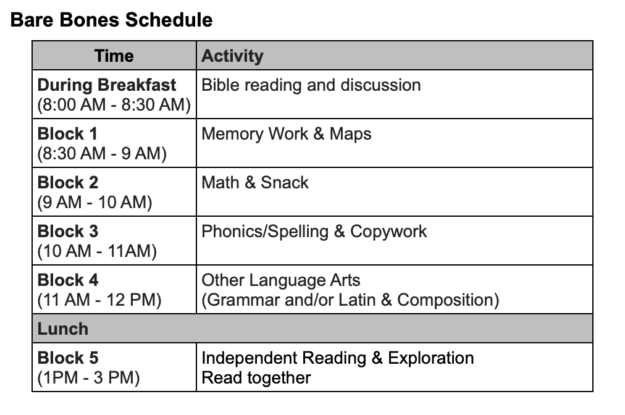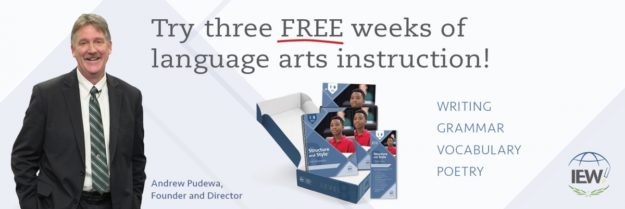
When our eldest son graduated two years ago, I had no idea how much it would shift my priorities and our family dynamic. While it’s been a joy to watch him pursue his post-homeschool educational endeavors (and work in his first research internship with Oak Ridge National Laboratory), the honest truth is that… when he graduated and left for college, a piece of my heart went with him.
And now, even though I’m still adjusting to our first son’s graduation, we’re preparing our second son to launch out of homeschooling at the end of this school year. I’m not ready for another senior because it means the end of another homeschool journey. And I have so loved homeschooling each of our boys through high school. It’s exciting to enter into this new chapter of their lives, but man. It’s so hard to let go.
So… in case you’re wondering why it’s been quiet over here, I’m finding it harder and harder to write blog posts and engage on social media and write newsletters because my perspective has shifted so much. Time with my family is just so precious.
Before I share more, I just want you to know… I am a real mom. Our family may run a curriculum business, but, first and foremost, we are a family who loves to spend time together and aims to love and serve God well. I enjoy writing curriculum and sharing ideas (and my husband enjoys shipping, receiving, and customer service), but I am not that mom who has it all together. My ongoing prayer is that what we share here and what our business stands for continues to bless other families. My husband and I are grateful for the opportunity to homeschool our family alongside yours even as our lives shift and transform into a new normal.
Before providing a sneak peek at our schedules and curriculum selections, I wanted to revisit my top lessons learned from our first fifteen years of homeschooling…
Lessons Learned from Fifteen Years of Homeschooling
- Seek first the kingdom of God. Loving God and fellow man (including siblings) takes precedence over everything else.
- Relationship is far more important than curriculum and lesson plans. Get to know your children and their interests. Seek opportunities to encourage them in those interests, but also hold them accountable to do their best in whatever they do.
- Young children operate best with short 15-minute lessons and plenty of time to explore nature and use their hands. (Boys especially struggle with sitting at a desk for long periods of time. We’ve completed our book work on the playground, the trampoline, the patio, sitting upside down in a chair…)
- Reading together provides an opportunity to build your family’s relationships through shared stories and discussion. During family read aloud time, it’s okay if children are using their hands (playing with LEGOs, coloring, etc.). In fact, we’ve found that it’s necessary.
- Give yourself and your children the grace of tapering into the school year, taking breaks when needed, and doing whatever needs to be done in the midst of your real, everyday lives.
- Be prepared, but hold your plans and expectations loosely, for God may have a special unexpected purpose for your family to pursue.
- Focus on learning and character-building rather than grades and test scores (at least until middle or high school).
- Resist falling into the trap of comparison. Comparison is the death of contentment. Do what’s best for your family, regardless of what others say and do.
- Choose joy. Learning can be hard, but it’s also exciting and rewarding. If you’re filled with a sense of dread as you enter a new school year, it’s time to change what you’re doing.
- If you’re new to homeschooling, start simple. Reading, writing, and arithmetic. These are the foundational skills needed for learning anything. Add other things when you discover interests and giftings.
- Be confident but also recognize that plan doesn’t equal reality. As with starting anything new, it may be a rocky road at first. (Remember, mercy triumphs over judgment!) Pray for guidance, wisdom, and grace, and lay all your efforts at the feet of Jesus. It’s all for Him anyway!
Homeschool Schedules
Let me take you back to when we first started homeschooling. What follows is a bare bones schedule for learning the basics.

This was the schedule we followed until our thirst for more truth, goodness, and beauty prompted us to seek new learning adventures beyond the basics. Over time, our family started to long for the wonder and beauty of music, art, poetry, science, and literature. We discovered the passions of our children and pursued hands-on history studies with our eldest (who has always loved history). Then we felt a genuine desire to make the Great Commission the focus of our learning endeavors. And as our oldest boys became teenagers, we wanted to stay connected in our learning even though they were studying high-school level material. And so our reading plans, blog posts, and schedules morphed over time to look more like this:

This schedule is just a guideline we’ve used in the past. In reality, our homeschool is more of a juggling act. After our morning time (which consists of activities we use to jumpstart our school day), our high schoolers follow a somewhat independent schedule, choosing the order in which they complete assignments, and they engage me in discussions or ask questions as needed. When I’m working with our youngest, his brothers are working on something they can do without my assistance so that they don’t interrupt — and vice versa.
Curriculum Choices
We have two students in high school and one in elementary (and one in college). Before the school year starts, I usually take each of our children out individually for a “dessert date.” This is where we set goals and choose curriculum for the year. I love to set goals with my children, and I love learning with them. It’s one of the greatest reasons we homeschool. Another reason is learning together, which leads me to…
Family Morning Time
Our family (from our youngest though our teenagers) starts together with a common morning time over breakfast.
- Bible. Read Scripture Series. We’re focusing on the Old Testament prophets this year. We watch the overview videos for each book (which we highly recommend!) and then read through that book of the Bible. This year, we aim to complete all of the prophets along with 1 and 2 Chronicles.
- We’re loosely following Mission: Lasting Liberty. This plan includes Bible, U.S. history, hymns, art, music, poetry, geography, science, scripture memorization, and read-alouds. Memory work includes poetry & hymns, U.S. geography, and scripture.
After that, our older students are fairly independent in their individual work and just ask questions as they need my assistance. After morning time, most of my day is spent on teaching writing and math to the youngest, discussing literature/philosophy/finance with the olders, and answering questions as needed.
Elementary (4th grade)
This year ushers us into another shift in our homeschool. Our third son is in 9th grade, leaving only one of our children in the lower grades. Our youngest son started 4th grade this week. He knows how to read and write and multiply now. It’s the first year in many that I won’t be using All About Reading because… well, he finished it. Three of our sons have asked me to not sell our All About Reading curriculum. I guess I’ll have to write that one into our Last Will and Testament.
So… here’s what he is working on this year:
- Poetry Memory Work. Linguistic Development through Poetry Memorization. Our boys love Andrew Pudewa, and they love memorizing poetry. Try this program free here!
- Math: Math U See Delta
- History, Geography, Scripture, Science, and Fine Arts: Loosely following Mission: Lasting Liberty combined with Time Travelers hands-on U.S. history studies. If you’re a crafty family, definitely check these out.
- Language arts:
- Spelling: This year, we’re checking out some various spelling curricula.
- English Grammar: Fix-It Grammar – Level 2 (15 minutes). We’ll work through these short, simple lessons to reinforce mechanics and editing skills over the course of the year. This is the quickest, most effective way to apply English grammar and mechanics. Read the reasons we love this program so much, and/or try it free here!
- Composition: Structure and Style for Students Level A. We highly recommend checking out the first three weeks of Structure & Style for Students program from IEW. (You can access the first three weeks free.)
-
- Literature selections for independent (or read-to-mom) reading – short chapter books:
- Pedro’s Journal
- The Matchlock Gun
- The Courage of Sarah Noble
- Phoebe the Spy
- Seaman’s Journal
- Thomas Edison: Young Inventor
- We’ll Race You, Henry
- The Story of George Washington Carver
- 26 Fairmount Avenue (and Here We All Are)
- Helen Keller Scholastic Biography
- Homer Price
- Charlotte’s Web
- Selections from the Who Was series and American history leveled readers, and American History Picture Books
- Literature selections for independent (or read-to-mom) reading – short chapter books:
High School (9th grade)
Our 9th grader will be following our Truth Trek One High School Lesson Plans for U.S. History (1 credit), English I – American Literature (1 credit), and Civics (1/2 credit). (If you’re interested in using our high school lesson plans, Truth Trek One provides a full, 36-week schedule for 9th grade.) Because he’s a year ahead in math and I wanted to teach chemistry and personal finance to both of our current high schoolers at the same time, he’s also following plans I’ve written for Personal Finance (1/2 credit), Chemistry (1 credit), Geometry (1 credit), and Foreign language – Spanish I (1 credit). This means I’ve already written the plans for some of the subjects for our next round of high school lessons, Truth Trek Two, to be released before next summer. Here’s the lowdown on what he’ll be doing this year:
- U.S. History to the Early 1900s (full year): Dave Raymond’s American History. (We love this history course! Read our review here. Download some free lessons: American History)
- American Literature & Composition (full year): Advanced U.S. History-Based Writing Lessons
- American Literature:
- The Last of the Mohicans
- The Scarlet Letter
- Excerpts from The Autobiography of Benjamin Franklin
- The Narrative of the Life of Frederick Douglass
- Uncle Tom’s Cabin
- The Adventures of Huckleberry Finn
- The Red Badge of Courage
- Up from Slavery
- To Kill a Mockingbird
- The Boy on the Wooden Box
- The Old Man and the Sea
- Select short stories and poetry
- Instead of using regular comprehension literature guides, our family’s literature discussions follow the Teaching the Classics Approach. (We highly recommend Teaching the Classics for parents to learn how to discuss literature with their children!) Students can fill out a story chart for each work of literature this year while also practicing the art of narration. Use code REF6CA9VNCSMT to receive 15% off your first order of $100.
- American Literature:
- Chemistry (full year lab science): Discovering Design with Chemistry
- Math – Geometry (full year): Math U See Geometry
- Foreign Language (full year): Spanish Grammar from Latin Roots along with Madrigal’s Magic Key to Spanish, and All Spanish Method by Guillermo Aviles. Our third son completed Visual Latin last year during middle school so he could proceed with Spanish in high school. He has wanted to work in construction since age 2, so Spanish Grammar from Latin Roots will be his high school level foreign language.
- Personal Finance (Required Elective – 1st Semester): Dave Ramsey Foundations in Personal Finance. This is their favorite course.
- Government (Required Elective – 2nd Semester): Notgrass Exploring Government (specifically, the Exploring Government Curriculum Package and the corresponding Student Review Pack)
High School (12th grade)
Our 12th grader officially needs only two credits to graduate (Personal Finance (1/2), Government (1/2), and English IV (1)), but he’s taking additional coursework in science and math because he has decided to pursue a major in electrical engineering. He has already earned 15 hours college credit due to his score on the ACT, the American history CLEP test (which he took after completing Dave Raymond’s American History a few years ago), the American Literature CLEP, and the Microeconomics CLEP. This year, he aims to take additional CLEP tests in chemistry and other subjects. (To learn more about what we think is the best way to earn college credit in high school, click here.) What’s listed below is what he has chosen to study.
- Chemistry (full year lab science): Discovering Design with Chemistry
- Math: Math-U-See Pre-Calculus.
- Exposition & Composition: Walking to Wisdom Guides for The Lord of the Rings. Other reading & composition will come from philosophy and British literature selections.
- Personal Finance (Required Elective – 1st Semester): Dave Ramsey Foundations in Personal Finance
- Government (Required Elective – 2nd Semester): Notgrass Exploring Government (specifically, the Exploring Government Curriculum Package and the corresponding Student Review Pack)
- Philosophy: Consequences of Ideas. This is a course that we’re both going through based on R.C. Sproul’s book Consequences of Ideas.
- Preparation for additional CLEP exams
If you’d like to take a look at a scope and sequence for fulfilling history credits, visit this post.
Many of the resources above are part of the Compass Classroom Membership, a monthly subscription option allowing homeschool families access to over 30 courses. You can test drive all the courses for free!
If you have any questions about this schedule, about any of our curriculum choices, or about planning in general, feel free to drop down to the comments or send us an email! We’d love to hear from you!
[I am] confident of this very thing, that he which has begun a good work in you will perform it until the day of Jesus Christ: -Philippians 1:6




